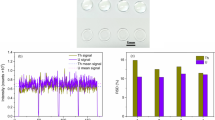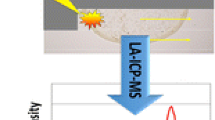Abstract
In this study, we employed laser ablation/inductively coupled plasma mass spectrometry (LA-ICP-MS) to map the spatial distribution of Gd-doped iron oxide nanoparticles (IONPs) in one tumor slice that had been subjected to magnetic fluid hyperthermia (MFH). The mapping results revealed the high resolution of the elemental analysis, with the distribution of Gd atoms highly correlated with that of the Fe atoms. The spatial distributions of C, P, S, and Zn atoms revealed that the effect of MFH treatment was significantly dependent on the diffusion of the magnetic fluid in the tissue. An observed enrichment of Cu atoms after MFH treatment was probably due to inflammation in the tumor. The abnormal distribution of Ni atoms suggests a probable biochemical reaction in the tumor. Therefore, this LA-ICP-MS mapping technique can provide novel information regarding the spatial distribution of elements in tumors after cancer therapy.

Mapping and ion intensities of a 56Fe and b 158Gd atoms. The red line indicates the path taken during the time-resolved analyses of Fe and Gd atoms






Similar content being viewed by others
References
Gilchrist RK, Medal R, Shorey WD, Hanselman RC, Parrot JC, Taylor CB (1957) Selective inductive heating of lymph nodes. Ann Surg 146:596–606
Jordan A, Scholz R, Wust P, Fahling H, Felix R (1999) Magnetic fluid hyperthermia (MFH): Cancer treatment with AC magnetic field induced excitation of biocompatible superparamagnetic nanoparticles. J Magn Magn Mater 201:413–419
Johannsen M, Gneveckow U, Thiesen B, Taymoorian K, Cho CH, Waldöfner N, Scholz R, Jordan A, Loening SA, Wust P (2007) Thermotherapy of prostate cancer using magnetic nanoparticles: Feasibility, imaging, and three-dimensional temperature distribution. Eur Urol 52:1653–1662
Baker L, Zeng Q, Li W, Sullivan CR (2006) Heat deposition in iron oxide and iron nanoparticles for localized hyperthermia. J Appl Phys 99:08H106
Fortin J-P, Wilhelm C, Servails J, Ménager C, Bacri J-C, Gazeau F (2007) Size-sorted anionic iron oxide nanomagnets as colloidal mediators for magnetic hyperthermia. J Am Chem Soc 129:2628–2635
Zhao D-L, Zeng XW, Xia QS, Tang JT (2009) Preparation and coercivity and saturation magnetization dependence of inductive heating property of Fe3O4 nanoparticles in an alternating current magnetic field for localized hyperthermia. J Alloys Compd 469:215–218
Kim DH, Lee SH, Im KH, Kim KN, Kim KM, Shim IB, Lee MH, Lee YK (2006) Surface-modified magnetite nanoparticles for hyperthermia: preparation, characterization, and cytotoxicity studies. Curr Appl Phys 6:e242–e246
Jordan A, Wuar P, Fählin H, John W, Hinz A, Felix R (1993) Inductive heating of ferrimagnetic particles and magnetic fluids: physical evaluation of their potential for hyperthermia. Int J Hyperther 9:51–68
Brusentsova TN, Brusentsov NA, Kuznetsov VD, Nikiforov VN (2005) Synthesis and investigation of magnetic properties of Gd-substituted Mn–Zn ferrite nanoparticles as a potential low-Tc agent for magnetic fluid hyperthermia. J Magn Magn Mater 293:298–302
Chen S, Chiang C-L, Hsieh S (2010) Simulating physiological conditions to evaluate nanoparticles for magnetic fluid hyperthermia (MFH) therapy applications. J Magn Magn Mater 322:247–252
Lemke A-J, Senfft von Pilsach M-I, Lübbe A, Bergemann C, Rless H, Felix R (2004) MRI after magnetic drug targeting in patients with advanced solid malignant tumors. Eur J Radiol 14:1949–1955
Reinl HM, Peller M, Hagmann M, Turner P, Issels RD, Reiser M (2005) Ferrite-enhanced MRI monitoring in hyperthermia. Magn Reson Imag 23:1017–1020
Di Marco M, Sadun C, Port M, Guilbert I, Couvreur P, Dubernet C (2007) Physicochemical characterization of ultrasmall superparamagnetic iron oxide particles (USPIO) for biomedical application as MRI contrast agents. Int J Nanomed 4:609–622
Cantillon-Murphy P, Wald LL, Zahn M, Adalsteinsson E (2010) Proposing magnetic nanoparticle hyperthermia in low-field MRI. Magn Reson A 36:36–47
Jing X-H, Yang L, Duan X-J, Xie B, Chen W, Lim Z, Tan H-B (2008) In vivo MR imaging tracking of magnetic iron oxide nanoparticle labeled, engineered, autologous bone marrow mesenchymal stem cells following intra-articular injection. Jt Bone Spine 75:432–438
Chen Y-C, Hsiao J-K, Liu H-M, Lai I-Y, Yao M, Hsu S-C, Ko B-S, Chen Y-C, Yang C-S, Huang D-M (2010) The inhibitory effect of superparamagnetic iron oxide nanoparticle (Ferucarbotran) on osteogenic differentiation and its signaling mechanism in human mesenchymal stem cells. Toxicol Appl Pharmacol 245:272–279
Zvyagin AV, Zhao X, Gierden A, Sanchez W, Ross JA, Roberts MS (2008) Imaging of zinc oxide nanoparticle penetration in human skin in vitro and in vivo. J Biomed Opt 13:064031
Mesjasz-Przybylowicz J, Przybylowicz WJ (2002) Micro-PIXE in plant sciences: present status and perspectives. Nucl Instrum Methods B 189:470–481
Mcdonnell LA, Heeren RMA (2007) Imaging mass spectrometry. Mass Spectrom Rev 26:606–643
Becker JS, Zoriy MV, Dehnhardt M, Pickhardt C, Zilles K (2005) Copper, zinc, phosphorus and sulfur distribution in thin section of rat brain tissues measured by laser ablation inductively coupled plasma mass spectrometry: possibility for small-size tumor analysis. J Anal Atom Spectrom 20:912–917
Becker JS (2010) Bioimaging of metals in brain tissue from micrometre to nanometre scale by laser ablation inductively coupled plasma mass spectrometry: state of the art and perspectives. Int J Mass Spectrom 289:65–75
Santos MC, Wagner M, Wu B, Scheider J, Oehlmann J, Cadore S, Becker JS (2009) Biomonitoring of metal contamination in a marine prosobranch snail (Nassarius reticulatus) by imaging laser ablation inductively coupled plasma mass spectrometry (LA-ICP-MS). Talanta 80:428–433
Becker JS, Zoriy MV, Pickhardt C, Palomero-Gallagher N, Zilles K (2005) Imaging of copper, zinc, and other elements in thin section of human brain samples (hippocampus) by laser ablation inductively coupled plasma mass spectrometry. Anal Chem 77:3208–3216
Zoriy MV, Dehnhardt M, Matusch A, Becker JS (2008) Comparative imaging of P, S, Fe, Cu, Zn and C in thin sections of rat brain tumor as well as control tissues by laser ablation inductively coupled plasma mass spectrometry. Spectrochim Acta B 63:375–382
Jackson B, Harper S, Smith L, Flinn J (2006) Elemental mapping and quantitative analysis of Cu, Zn, and Fe in rat brain sections by laser ablation ICP-MS. Anal Bioanal Chem 384:951–957
Matusch A, Depboylu C, Palm C, Wu B, Höglinger GU, Schäfer MK-H, Becker JS (2010) Cerebral bio-imaging of Cu, Fe, Zn and Mn in the MPTP mouse model of Parkinson’s disease using laser ablation inductively coupled plasma mass spectrometry (LA-ICP-MS). J Am Soc Mass Spectrom 21:161–171
Hare D, Burger F, Austin C, Fryer F, Grimm R, Reedy B, Scolyer RA, Thompson JF, Doble P (2009) Elemental bio-imaging of melanoma in lymph node biopsies. Analyst 134:450–453
Seuma J, Bunch J, Cox A, McLeod C, Bell J, Murray C (2008) Combination of immunohistochemistry and laser ablation ICP mass spectrometry for imaging of cancer biomarkers. Proteomics 8:3775–3784
Drake P, Cho H-J, Shih P-S, Kao C-H, Lee K-F, Kup C-H, Lin X-Z, Lin Y-J (2007) Gd-doped iron-oxide nanoparticles for tumour therapy via magnetic field hyperthermia. J Mater Chem 17:4914–4918
Costello LC, Feng P, Milon B, Tan M, Franklin RB (2004) Role of zinc in the pathogenesis and treatment of prostate cancer: critical issues to resolve. Prostate Cancer Prostatic Dis 7:111–117
Ethem A, Yavuz G, Kocak M (2003) Effects of inflammation and antiinflammatory treatment on serum trace elements concentrations. Biol Trace Elem Res 93:95–103
Milanino R, Marrell M, Moretti U, Concari E, Velo GP (1988) Copper and zinc status in rats with acute inflammation: focus on the inflamed area. Inflamm Res 24:356–364
Hall DM, Baumgardner KR, Oberley TD, Gisolfi CV (1999) Splanchnic tissues undergo hypoxic stress during whole body hyperthermia. Am J Physiol Gastrointest Liver Physiol 276:G1195–G1203
Pani G, Galeotti T, Chiarugi P (2010) Metastasis: cancer cell’s escape from oxidative stress. Cancer Metast Rev 29:351–378
Nielsen FH, Hunt CD, Uthus EO (1980) Interactions between essential trace and ultratrace elements. Ann NY Acad Sci 355:152–164
Acknowledgements
We thank the National Science Council, Taiwan, for funding this project (contract number NSC99-2113-M-007-017), the Instrument Center at National Tsing Hua University for the ICP-MS support, and Professor C. S. Chiang (Department of Biomedical Engineering and Environmental Sciences, National Tsing Hua University) for his valuable assistance and insight.
Author information
Authors and Affiliations
Corresponding author
Rights and permissions
About this article
Cite this article
Hsieh, YK., Jiang, PS., Yang, BS. et al. Using laser ablation/inductively coupled plasma mass spectrometry to bioimage multiple elements in mouse tumors after hyperthermia. Anal Bioanal Chem 401, 909–915 (2011). https://doi.org/10.1007/s00216-011-5144-7
Received:
Revised:
Accepted:
Published:
Issue Date:
DOI: https://doi.org/10.1007/s00216-011-5144-7




